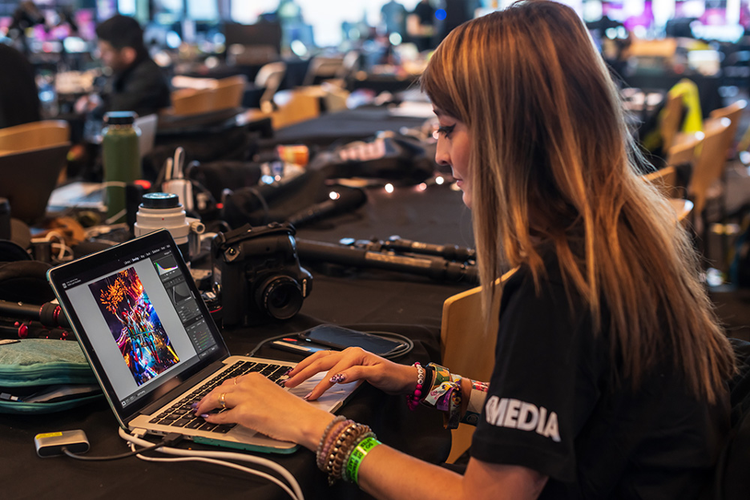Five tips to make your designs stand out for the judges

Image Source: Insomniac Events
Winning a creative challenge is more than an ego boost. It’s a pivotal moment in a young designer or artist’s career that can open doors and create opportunities. From photography contests to digital art competitions, there’s no better feeling than having your work validated by judges you respect and artists who inspire you most. Plus, creating a project based on a specific brief is an invaluable experience in the early stages of your career.
“Young designers are full of ideas, and these competitions are often their first big chance to flex. It’s an amazing opportunity to earn recognition from your peers and big-time players in the creative community,” said Nikolaos Lerakis, a former Adobe design challenge finalist and creative director at Duvernois Creative Spirits.
Each year, Adobe partners with leading artists and creative organizations around the world to host a series of design experiences, inviting creators to use provided templates and artwork themed to the challenges, to put their own spin on the prompt with a chance to win.
Our latest is in collaboration with the Electric Daisy Carnival (EDC), the world’s largest dance music festival. Fans can design their version of an EDC Art Car for a chance to see their creativity come to life digitally on the screens of this year’s official Boom Box Art Car. The Grand Prize will also include a $5,000 cash prize, a coveted mentorship with the EDC Creative team, two VIP festival passes, and a free 12-month subscription to Adobe Creative Cloud.
So how can you create a standout design that gets noticed — and where do you start? We asked former creative challenge participants, judges, and Adobe creative directors what sets winning designs apart, and what it takes to submit an Adobe Creative Challenge entry that you can be proud of.
1. Do your homework
Adobe executive creative director Adam Morgan has judged plenty of marketing and design awards and has wise words for young creatives looking to make their mark: “Study everyone’s styles, not just the ones you like. You need to know you’re not copying someone else’s work. If you don’t know, you haven’t studied enough,” he says.
Morgan says it’s also helpful to look back and see which designs caught the judges’ eye in previous years. The Adobe Creativity Tour makes its Hall of Fame entries publicly available, which is a great starting point to browse past winners and get inspired.
2. Stay focused
A creative challenge is an invitation to be original, but it’s not a blank slate.
“Take it from someone who still applies for design competitions to this day — the process is intense and takes lots of time,” says Lerakis. “If you’re going to work that hard, make sure you understand the nuances of the brief and what the judges are looking for before getting started. Once you know where you’re headed, you can unleash your originality and push the brief to its limits without losing sight of the end goal.”
For Morgan, it’s just as important to stay focused throughout the design process.
“Lots of designers try to do too much when they start out,” he says. “Great design isn’t about showcasing everything you can do, it’s about removing the fluff and creating a clear concept that other people can relate to. When it comes to creative challenges, those people are the judges who only have 20 seconds to review each entry, which means they’ll pass on any design that’s overly complicated.”

Image Source: Insomniac Events
3. Be mindful of the brief
A common pitfall of design submissions is that while many are beautiful and intriguing, they’re not always relevant to the challenge at hand. For example, applicants to the EDC art car challenge may get caught up in the aesthetics and forget to consider transportation.
“When designing an art car, you need to think of how it looks, but you also need to keep in mind how it will pack and travel from show to show,” said the Insomniac creative team. “Otherwise, it’s just a cool concept that doesn’t meet the brief.”
When it comes to the challenges Adobe runs with musicians and other artists, judges also appreciate designs that align with their personal style.
“Remember that competitions are about bringing fans closer to these artists, each of which has a distinct visual identify,” says Michael Jarrott, creative director at Adobe. “Make sure you step into their world when creating your design. I often blast their music in my studio to get myself in the same headspace as the person I’m designing for.”
4. Take the opportunity to play
Jarrott has been judging Adobe Creativity Tour challenges since their inception. As a creative director, he likes to see designers take liberties with the assets and tools they use to create their entries.
“Most Adobe challenges come with a set of assets for applicants to use in their designs, from quick-start templates to recommended color palettes, but winners always find a way to transform what we give them into something new,” he says.
“These assets are just a resource to get you started. Creative challenges are an opportunity for designers to play, which is exactly what judges expect: someone who makes their joy come across in their work and who isn’t limited by what’s in front of them,” Jarrotst adds. “After all, we rarely remember designs that feel easy or obvious. There’s always an element of rule-breaking.”
For the EDC team, playful design should bring people together. This ethos is a driving force between the art cars it creates each year with Adobe’s Creative Challenge winners.
“Bringing people together is more important than ever, art cars are the underground of our shows and always provide a place for people to meet and connect. As we look at the year ahead, I hope designers can create more spaces that emphasize community and bring people together,” said the Insomniac creative team.

Image Source: Insomniac Events
5. Don’t forget: the discovery is in the doing
It’s great to win, but for Morgan, the real joy and validation of creative challenges is in the doing.
“I remember spending days on end prepping my entries, spending as much time on research as on the work itself,” he says. “If you have imposter syndrome, which I still do 20 years into my career, this is a chance to put your work out there and let others validate your talents.”
Lerakis agrees. He was a finalist for the Adobe Achievement Award in 2010, which earned him an all-expenses paid trip to Los Angeles and put him touch with peers and inspiring creative from across the content community.
“I didn’t win, and looking back I could have played with more features of Adobe’s creative apps to take my design further, but the experience was a positive in every way because of what I learned on the journey. The confidence boost that comes with seeing your work recognized on a massive stage is unbeatable. It inspired me to keep learning and experimenting with my designs, and that’s worth more than any prize.”
Ready to submit your design? Check out the details of the EDC X Adobe creative challenge to get started. Good luck!